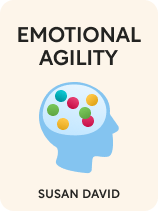
How do you feel right now? What’s going on around you at this moment?
It’s important to view your emotions with objectivity. Clinical psychologist Susan David says that, when it comes to your present emotions, mindfulness can help you be real about what you’re feeling and why.
Read more to learn how to achieve mindfulness of emotions and stay in sync with reality.
Mindfulness of Emotions
Your brain is programmed to take in sensory information and interpret it through narratives explaining how and why the world works. David explains that people instinctively believe these narratives are true because they’re informed by emotions, which we’re wired to pay attention to. This is the case even when the narratives aren’t true.
Mindfulness of emotions can help you avoid being taken in by false narratives. Mindfulness is the act of paying attention to your senses, emotions, and surroundings without judgment. David suggests that, by paying attention to the stimuli in your surroundings—and the emotions that arise from your thoughts about these stimuli—you can weaken your instinct to believe your narratives. Your brain avoids mindfulness to save you mental energy in everyday life: If you can pour a glass of water without paying close attention, you’ll likely do so on autopilot every time you’re thirsty. While on autopilot in this way, you’re more susceptible to your narratives and emotions controlling you.
However, David says you don’t need to be mindful at every moment in order to ward against narrative and emotional control. Instead, pay deliberate attention to your surrounding stimuli from time to time throughout the day. You’ll gradually become more mindful with practice.
| A Buddhist Perspective From Mindfulness in Plain English David briefly mentions that you shouldn’t judge your emotions and perceptions while practicing mindfulness. Looking into the original Buddhist principle of mindfulness clarifies the importance of a nonjudgmental perspective. In Mindfulness in Plain English, Buddhist monk Gunaratana describes a few characteristics of mindfulness as they relate to being aware of—but not assigning value to—your emotions and surroundings: • Mindfulness is nonconceptual awareness. There is no conscious thought, where judgment happens. • Mindfulness is nonjudgmental awareness. You can’t be aware if you’re judging all of the stimuli around you. • Mindfulness is awareness of change. However, while it watches this change, it doesn’t comment on it. While David’s principles of mindfulness align with Buddhist principles, her practical suggestions differ slightly. She says you can practice mindfulness by intensely focusing on objects or actions for a period of time. On the other hand, Gunaratana argues that mindfulness isn’t the same as concentration: Unlike mindfulness, which should have an element of ease, concentration requires effort and force. |

———End of Preview———
Like what you just read? Read the rest of the world's best book summary and analysis of Susan David's "Emotional Agility" at Shortform.
Here's what you'll find in our full Emotional Agility summary:
- Why most people react instinctively rather than objectively
- How to live according to your values to create the life you want
- How to handle your emotions better using mindfulness techniques






